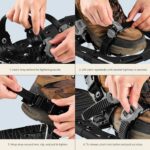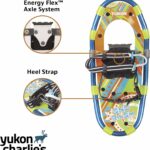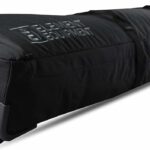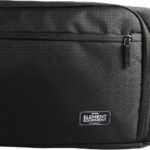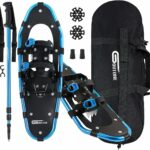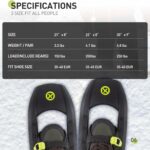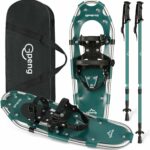Choosing the correct size for your snowshoes can be the defining element between an enjoyable winter hike and a frustrating struggle through the snow. This article will guide you through the factors that play a crucial role in defining the perfect snowshoes for you such as your weight, the terrain you’ll be trekking, and the type of snow you’ll encounter. Get ready to confidently step into your next winter adventure with snowshoes that are nothing short of a perfect fit!
Understanding the Importance of Snowshoe Sizing
You may be surprised to know just how much snowshoe sizing affects performance. The size of your snowshoes can impact your speed, comfort, and safety in snowy terrains. Making sure you have the correct size isn’t only about comfort—it can genuinely change your ability to effectively maneuver through snow.
How snowshoe sizing affects performance
Each snowshoe is designed to give optimal performance based on its size. Larger snowshoes give you more flotation which enables you to walk through deep snow easier. On the other hand, smaller snowshoes have less surface area which makes it easier to move and turn. Hence, depending on the type of journey you’re undertaking, snowshoe sizing plays a vital role in optimizing your performance.
Impact of incorrectly sized snowshoes
Incorrectly sized snowshoes can drastically hinder your snowshoeing experience. They can unnecessarily exhaust you, cause blisters or discomfort, and even risk your safety. For example, snowshoes that are too small for your weight can sink deeper into the snow making you exert more power while walking. On the other hand, snowshoes that are too big can compromise your agility, making you prone to tripping or falling.
Sizing considerations for different snow conditions
Different snow conditions require different snowshoe sizes. Light fluffy snow calls for larger snowshoes, providing better flotation, whereas smaller snowshoes are better suited for compacted or icy snow paths where maneuverability and grip is key.
Basics of Snowshoe Sizing
Understanding the basic principles of snowshoe sizing is essential. It’s about more than just the length or width of the snowshoe, it’s a combination of your body weight, gear weight, and the type of snow and terrain where you’ll be travelling.
The role of weight in choosing the right size
Your total weight including your gear has a significant influence on the size of the snowshoes you need. The heavier you are, the larger snowshoes you need to maintain flotation as your weight is distributed over a wider surface.
Explaining ‘flotation’ in snowshoe sizing
Flotation refers to the snowshoe’s ability to stay on top of the snow. Larger snowshoes offer more flotation because they distribute your weight over a larger surface area, preventing you from sinking into the snow. However, while it’s generally beneficial to have greater flotation in deep or powdery snow, it may hamper your mobility in packed or hard snow.
Size variations based on snowshoe styles
Not all snowshoes are the same. There are recreational snowshoes, backcountry snowshoes, and running snowshoes, each varying in size and shape. Recreational snowshoes are larger for better flotation, whereas backcountry snowshoes have a tapered shape for better maneuvering in uneven terrains. Running snowshoes are the smallest and the lightest.
Snowshoe Sizes for Adults
Just as with regular shoes, finding the right size snowshoe is crucial. However, instead of fitting onto your foot, a snowshoe must fit your need based on activity, weight, and snow conditions.
Typical size ranges for adult snowshoes
In general, adult snowshoes come in sizes ranging from about 22 inches to 36 inches in length. These sizes are further divided into categories such as small, medium, and large, correlating to the weight they can support.
Factors influencing size choice for adults
Several factors can influence the size choice for adults. Apart from your weight, these factors can include terrain, snow conditions, and activity type. A lighter person on fluffy snow may require larger snowshoes, whereas a heavier person on compact snow may need smaller ones. Your preferred activity whether it’s hiking, running, or mountaineering will also impact your size choice.
How to measure for adult snowshoes
Measuring for adult snowshoes isn’t as straightforward as measuring your foot for a shoe. Instead, you need to consider factors such as your weight, the weight of any gear you’ll be carrying, the type of terrain you’ll be on, and the type of snow you’ll be walking on. Remember, the goal is to achieve a balance between flotation and maneuverability.
Snowshoe Sizes for Children
Snowshoeing is a fun activity for kids to explore snowy landscapes. However, selecting a proper size for children is crucial to ensure they can walk comfortably and safely.
Importance of proper sizing for kids
Just like adults, children need correctly sized snowshoes to enjoy their snowshoeing adventure. An appropriately sized snowshoe will ensure that your little ones can comfortably maneuver through the snow without exerting unnecessary energy.
Typical size ranges for children’s snowshoes
For youngsters, snowshoes are commonly available in lengths ranging from 14 to 19 inches. These sizes are designed to support lower weights and smaller steps.
Using shoe size as a reference for sizing
If you’re confused about what size to choose for your child, looking at regular shoe sizes can be a good starting point. A child with a smaller shoe size will typically need a smaller snowshoe, while a kid with a bigger shoe size might require a larger snowshoe. However, it’s important to remember that this is just a reference point and other factors like weight and snow conditions should also factor into your size choice.
Snowshoe Sizes for Specific Activities
The type of activity you’re planning greatly affects the size of snowshoes you should choose. An adventure through deep backcountry snow requires much different snowshoes than a simple hike on a compacted trail.
Sizing for hiking and backpacking
Hiking and backpacking in snow usually require larger snowshoes as they offer better flotation on loose, untracked snow. These are usually about 25 to 36 inches and can support weights up to 300 pounds including equipment.
Sizes for flat terrains
If you’re walking across flat terrain with well-packed snow, smaller snowshoes are a good choice. They offer better maneuverability and are easier to walk in, especially for beginners. Typical sizes range from around 22 to 25 inches.
Sizes for rolling or mountainous terrains
For rolling or mountainous terrains with varied snow conditions, you would need a size in between – one that offers enough flotation, but still allows for easy movement and turning. The sizes can vary somewhere between 25 to 30 inches, depending on your weight and the snow conditions.
Considering Terrain and Snow Condition
As mentioned earlier, the conditions of both the terrain and snow play a significant role in determining the appropriate snowshoe size.
Effect of snow type on snowshoe size
Snow can be powdery, packed, icy, or slushy, and each type requires a different size of snowshoe. Powdery snow requires larger snowshoes, while icy, and packed snow require smaller, more manageable snowshoes. Slushy conditions can be a little tricky; smaller snowshoes with additional traction can be a good fit.
The link between terrain steepness and snowshoe size
The steepness of the terrain has a direct link to snowshoe size. Flat and mild terrains don’t require a lot of turning or climbing, so larger snowshoes can be used for better flotation. However, on steep and uneven terrain, smaller snowshoes are more suitable as they make climbing easier and provide better control and stability during descents.
Adjusting snowshoe size for different snow conditions
It’s important to remember that snow conditions may change from day to day. Therefore, adjusting your snowshoe’s size accordingly is vital. If you’re a regular snowshoer with varying routes and snow conditions, consider having different sizes of snowshoes to provide you the best experience each time.
Tips for First-Time Snowshoe Buyers
Your first pair of snowshoes is an important investment. Make sure you make the right pick by considering the following tips:
First-time sizing recommendations
For beginners, it’s generally recommended to start with all-around snowshoes — not too large, not too small. Sizes around 22 to 25 inches are a good starting point as they can work well on different snow conditions and terrains.
Try before you buy: The importance of fit tests
If you have the opportunity, always test out the snowshoes before purchasing them. Walk around, make sideway steps, and see if the bindings fit well with your winter boots. Ensure the snowshoes feel comfortable and secure on your feet.
Key features first-time buyers should look for
Look for snowshoes with adjustable bindings for a more secure fit. Heel lifts or “climbing bars” are great for steep terrains as they reduce calf strain. For traction, many snowshoes offer side rails and crampons. Also, find snowshoes that have a good balance between flotation and maneuverability.
Adjusting Snowshoe Bindings for a Perfect Fit
Getting the right size of snowshoes is just the beginning. Making them fit perfectly involves properly adjusting the bindings.
How to adjust snowshoe bindings
Most snowshoes today come with adjustable bindings that you can customize to your boots. These bindings usually include heel straps and forefoot straps that can be tightened or loosened. Always ensure your feet are centered over the snowshoes with a snug, but not overly tight fit.
Importance of properly adjusted bindings
Properly adjusted bindings not only ensure comfort but also keep your feet secure and prevent them from slipping. This makes walking easier, reduces fatigue, and promotes safety.
Addressing common fit issues
Common fit issues include loosening straps, narrow or wide bindings, or pressure points. Always remember that the bindings should be snug but comfortable. Readjust whenever necessary to ensure maximum comfort and safety during your journey.
Maintaining Your Snowshoes for Long-Term Use
Once you’ve found the perfect size and fit, maintaining your snowshoes in good condition will ensure they last for years to come.
Basic care and maintenance tips
Always clean your snowshoes after each use. Dry them properly before storing to prevent rust. Check all the parts regularly to spot any damage or wear and tear.
The impact of proper maintenance on sizing
Proper maintenance is crucial for long-term comfort and performance. It ensures your bindings remain adjustable for a secure fit. Moreover, keeping crampons and side rails sharp ensures proper traction at all times.
How to check for sizing inconsistencies over time
Always ensure your snowshoes perform the way they’re intended to in the snow. If you feel like you’re sinking too much or if you find it hard to maneuver in conditions where you previously had no issues, it might be time to re-evaluate the size of your snowshoes.
Reviewing Popular Snowshoe Brands and Models
There are countless snowshoe brands and models out there, and sifting through them all can be daunting. But understanding how they differ in terms of size offerings can help make your decision easier.
Comparing size offerings across brands
Different brands may offer slightly different size ranges and categories. Some may categorize by weight while others may use a person’s height. Therefore, make sure to read sizing charts and information carefully for each brand.
Analyzing user reviews for insights on sizing
User reviews can provide valuable insights into a product’s performance. Look for reviews that mention the snowshoe’s size and how it performed in various conditions. This can help you make a more informed decision.
Sizing issues are among the most common topics in product reviews. Take note of any size-related complaints or praises – they can provide real-world feedback and insights which can guide you in choosing your snowshoe size.
- What Snowboard Bindings Should I Get? - January 23, 2024
- What Size Screws For Snowboard Bindings? - January 23, 2024
- How To Snowmobile On Water? - January 23, 2024

